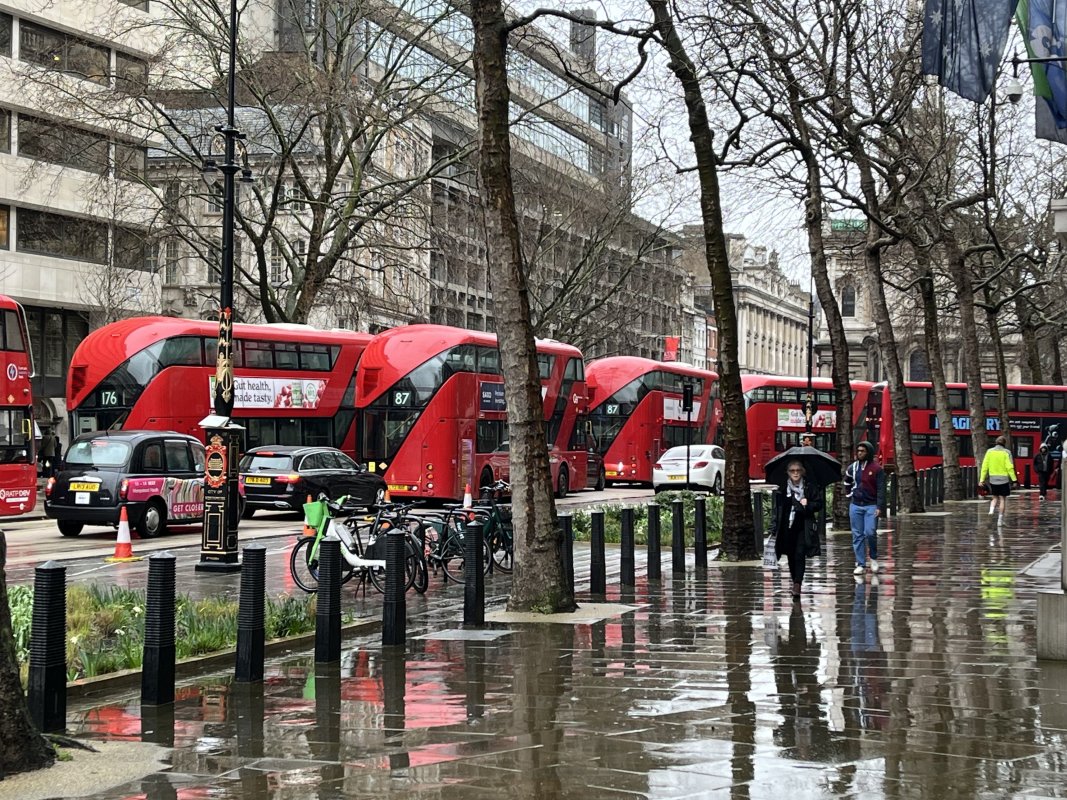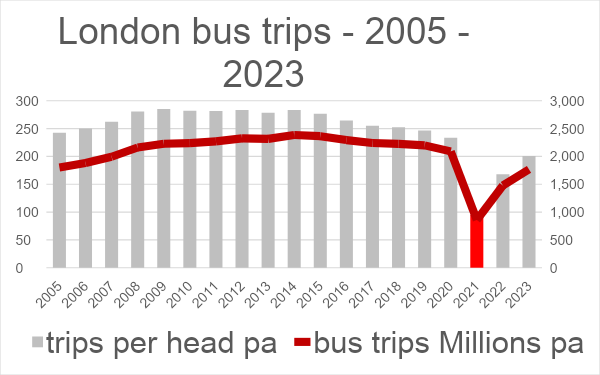
London’s incredibly shrinking bus network
The on-going decline of London's bus network seems to have gone largely unnoticed by many commentators and politicians. Not a month goes by without a city calling for a "London-style" bus network; but these requests seem to relate to the London of the early 2000s, not the reality of 2024.
Let's consider a few facts:
- London bus demand peaked in 2014 - that means ten years of decline, with patronage now back at 2005 levels
- But London’s population has grown by 1.2m people (14%) over that period
- So if we look at bus trips pa, per head of population (a good measure of bus demand), London has dropped by c24%
- The subsidy in 2014 was £547m (23p per trip). By 2023 it was £786m (45p per trip). That’s an increase of c95%. And even that understates the real picture, as we know that at least two London bus companies are reporting meaningful financial losses, which will have to be added to tender prices when contracts expire.
- In response, TfL has so far cut the network by c.1,000 buses (10%) since 2017, by thinning frequencies and removing entire routes (especially in the central areas).
So what's gone wrong? It's the old story of rising costs and falling patronage. But what is striking here, is that many of these trends are the result of TfL's own policies. TfL was supposed to be about ‘joined-up’ policymaking, across buses, rail, and highways. Over the last 10+ years, TfL has prioritised cycle schemes, rail improvements and air quality, and apparently given up on ‘reasons to travel’ marketing.
The cycle and pedestrian schemes grow in extent every month, and have led to extreme loss of junction capacity, selective removal of bus lanes, and huge reductions in bus speeds. For short journeys it is often quicker to walk in central and inner areas (and nearly always quicker to cycle, for those who can). But as bus speeds fall, operating costs rise (because the costs of buses and drivers are mainly hourly), and ridership falls. It’s a classic ‘double whammy’, and visible in the queues of lightly loaded buses waiting at lights all over central London. (Given the very low pre 2010 cycle usage, there is no contradiction in TfL claiming large percentage increases, but achieving low absolute take-up, as witnessed by the often empty cycle lanes and full racks of TfL hire bikes).

TfL’s rail schemes, including the Elizabeth Line, and post Covid demand changes, have released considerable capacity on previously overcrowded tube lines for disgruntled bus passengers. The time savings are huge versus bus. As someone who lives in east inner London, I often visit Covent Garden. It’s a four mile journey, that takes c 30 minutes by DLR and tube, but now up to an hour by direct bus (not much faster than a brisk walking speed). My local Route 15 illustrates the problems with TfL’s strategy. The frequency has been drastically cut. At Aldgate the route makes a long, slow diversion, even though the bus stops outside Aldgate East station have been removed to make way for cycle lanes. In Lower Thames Street, it is quite common to wait 10-15 minutes to make the left turn near the Tower, which has been largely given over to a lightly used ‘cycle superhighway’.
TfL has made commendable steps since 2016 to roll-out electric buses, but it makes little environmental sense for such expensive vehicles, to stand in traffic jams, or to trundle around at walking speed. And don’t forget that in many parts of London the maximum speed is now only 20-mph, with the average speed much lower than in the 1930s.
TfL seems to no longer have any systematic idea who buses (or roads) are for: the revealed policy seems to be to disadvantage low income workers, or the infirm, so that the ‘Lycra Louts’ employed by investment banks can race back home to St John’s Wood while the buses stand in traffic. And forget any discretionary growth in bus use at these speeds.
One may deduce that some parts of TfL management are aware of this contradiction, but the all-party elite consensus of ‘Two Wheels Good, Four Wheels Bad” makes any public discussion of the difficult trade-offs inherent in allocating scarce roadspace very difficult.
What is to be done? A more subtle balance is needed in the allocation of road-space. If London had Brighton-style speeds (and marketing), or Paris style segregated bus routes, the financial problems might ease. Instead it is reasonable to assume that bus speeds (and patronage) will continue to drop, as more cycle-first schemes are rolled out. TfL’s bus deficit could easily increase by 4-6% per annum (say 3% higher costs plus 3% lower revenue). And that is before the general inflation arising from staff wage rises and the higher short term costs of running electric buses. TfL is drifting back towards a model that relies on rising Treasury handouts to keep an ever-shrinking network going – a policy that was tested to destruction in the 1970s and 80s.

This article was written for Buses Magazine
